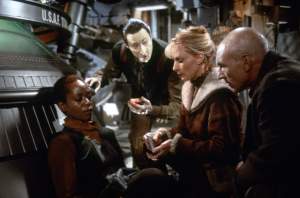Talkboy

kupca/moviestillsdb
Tiger Electronics was feeling itself in the 1990s.
The Talkboy (and later the Talkgirl) was unleashed on the world in 1992 as a promotional tie-in with the release of Home Alone 2: Lost in New York and quickly became one of the hottest toys of the year. Believe it or not, the prop came first, so it’s not a case of shameless product placement.
The original version of the handheld recording device used standard cassette tapes and chewed through four double-A batteries, though unlike the one used by Kevin McCallister in the movie it didn’t initially have the slo-mo playback function (that would come in a later deluxe model)
Troll Dolls

Rex K. Williams/shutterstock
The Troll Doll as a toy has had a couple of “hot periods” in the United States since its creation in Denmark in the late 1950s, including in the mid-60s, the late 80s, and of course the early 1990s.
With their signature shock of colorful hair (and occasionally jewel-embossed bellies), they were kind of the Funkos of their time, with seemingly infinite variations of the diminutive dolls. The early 90s even saw an attempt to market the Trolls specifically to young boys with the releases of the “Original Battle Trolls” by Hasbro.
Today, the dolls are best known as a major animated film franchise from Dreamworks.
Nickelodeon Gak

KMazur/WireImage
What 90s kid could ever forget the smell of Nickelodeon’s Gak? A scent never smelled before or replicated since. And who could forget how much trouble you’d get in when the Gak inevitably stuck to the wall or ceiling and left a greasy stain that’s never coming out?
While the specific origins of Gak are unknown, the product fit in well with Nickelodeon’s slime-focused television programs, and the term was likely first coined by Mark Summers, host of the classically sloppy game show Double Dare.
The success of Gak also led to plenty of variants and spin-off items like Gooze, Floam, Zzand, and Smud.
Tamagotchi/Giga Pet

Gorlov/istock
The meaning of the word Tamagotchi shouldn’t surprise anyone who owns one of these addictive electronic games — It’s simply a combination of the Japanese words for Egg and Watch.
The first wave of Tamagotchi came to America in 1996 and spread like wildfire. The actual gameplay involves using what were typically three buttons to perform tasks that provide care for your small digital pet, from egg through its full lifecycle, until it ultimately dies (don’t worry, you can reset it).
There were plenty of knockoffs and variations, with Tiger Electronics’ Giga Pet being the most common, but Tamagotchi was the one to own.
Furby

cafe-de-art/istock
The Furby craze of the late 90s is a lot like the AI craze of today, in that a Furby’s actual intelligence and learning abilities were vastly overstated and at the height of the craze, they were often incredibly overvalued.
The entire premise of the Furby was that they were highly interactive. The toy used infrared sensors to have the Furbys talk to one another and was designed to speak more English and less “furbish” over time to create the illusion of learning and growth. Combine that with rudimentary facial expressions and it was an incredibly impressive toy at the time.
Pogs

Rick Beauregard/shutterstock
This is one of those “you just had to be there” fads that will likely continue to be difficult to explain to new generations. Pogs were small cardboard discs that were collected and used to play the game, the object being to use a heavier “slammer” to flip said discs until one player won. The origins of the game are complicated, likely coming to Hawaii as a variation of a popular Japanese game and then spreading to the mainland.
These things were everywhere, and in the mid-90s for a brief period, one’s entire self-worth could be defined by their vast, impressive collection of unique Pogs and Slammers, or lack thereof.
Polly Pocket/Mighty Max

shutterstock/Luoxi
Polly Pocket was a unique toy created in the United Kingdom in the 1980s and exploded in popularity in the United States in the 1990s. Essentially, they’re miniature plastic dollhouses, with the first version being built into a makeup powder compact.
The world of Polly Pocket expanded quickly, and the tiny doll was joined by other alliteratively named friends like Little Lulu and Tiny Tina. The product was so successful that they eventually created a “boy” version of the toy: Might Max. Both lines, from Bluebird Toys, would go on to inspire popular animated television series, and Polly Pockets are still produced today by Matte.
Tiger Electronics Handheld Games

Tiger Electronics/Getty Images
These games were terrible. But when you have no other options (say, if your Gameboy runs out of batteries) you make do with what you have.
The actual technology was on the level of a digital watch. Small, digital lights moving on a static background, you “control” the outcome and score points, usually with a small D-pad and one or two action buttons.
The genius was the licensing. Tiger-made crappy games for IP like Jurassic Park, Batman, Spider-Man, Little Mermaid, Sonic the Hedgehog — you name it. Your imagination (with a little help from the licensed art printed on the plastic) did a lot of heavy lifting.
Some were better than others. All were bad. Many were completely unplayable. You had to have them.
Moon Shoes

Etsy
Like so many of the most-wanted toys in the 1990s, the idea sold by the marketing was infinitely more appealing than the toy itself. Perhaps there was a life lesson to be learned about the nature of advertising. If so, it went over many of our heads.
“They’re like kid power trampolines for your feet.” Or so the ads on Nickelodeon said. Bright neon green and purple, these plastic ankle-breakers strapped to your feet and hypothetically let you bounce around your driveway like a prepubescent Neil Armstrong.
Did they work as advertised? Not really, no. But everyone wanted a pair.
Super Soakers

haireena/shutterstock
Super Soaker changed the water fight game when the original Power Drencher (later redubbed the SS50) was released in 1990. What followed was a decades-long arms race, often dominated by whichever kid’s parents had the most expendable income.
There was seemingly a new gimmick every summer. Bigger tanks. More pressure. Eventually, some backpack-equipped super soakers could have you walking the Elm Street battlefield like Schwarzenegger in Commando. The men and women at the labs in Larami (and later Hasbro) were cooking in the 1990s.
Unfortunately, the quality of these high-powered water guns has fallen off dramatically in recent years. It’s such a shame. Those were wet and wild summers.







